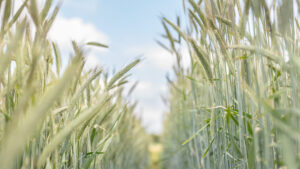How much do you know about triticale? Triticale is an artificial intergeneric hybrid between a female wheat parent and a male rye parent, according to the International Triticale Association. But, it wasn’t smooth sailing getting to the hybrid — there were quite a few achievements that needed to happen first to ensure the hybrids weren’t sterile. Here’s a brief history to keep in mind.
Origin: Triticale dates back to 1873, when Scottish Botanist A. S. Wilson made the first cross between wheat and rye — though, these first plants were sterile and couldn’t be multiplied.
TIMELINE:
- 1873: A. S. Wilson made the first cross between wheat and rye.
- 1888: German plant breeder W. Rimpau created a cross of wheat and rye that was partially fertile.
- 1921: G. K. Meister observed spontaneous pollinations of wheat plants with rye pollens from neighboring plots — though these hybrids were mostly sterile.
- 1937: Botanists learned that colchicine can ‘double’ the chromosomes in newly forming cells, which allowed a new systematic production of viable seeds. Meaning, it made triticale fertility no longer dependent on natural chance.
- 1948: A new triticale was made crossing durum wheat with rye by J. G. O’Mara.
- 1953: The first North American triticale breeding program was created at the University of Manitoba.
- 1960s: Triticale breeding programs extended into Mexico, Poland and France.
- 1967: A triticale plant was accidentally fertilized by pollen from nearby plots of dwarf bread wheat — after a few generations of selection, it resulted in a line called Armadillo, which helped resolve many agronomic problems.
- 1970s: Triticale breeding programs moved into Australia, Brazil and Portugal.
STATS:
90% is the percentage that Poland, Germany, China and France account for in terms of world triticale production.
2.1% is the amount of total global production of triticale the U.S. produced.
11% is the increase in yield that triticale has over wheat.
2 million is the number of acres that triticale is grown on in the U.S.
QUICK FACTS:
- Triticale has a savory, nutty flavor and is often included in prepared mixed-grain hot and cold cereals, muffin flours, pancake mixes and crackers.
- In the U.S., triticale is primarily used in livestock feed.
- In Mexico, triticale is used for whole-grain breads and tortillas.
- Triticale is making splashes in the ethanol realm, as it has a high start content and no hull, which makes alcohol production more efficient.
- Today, the most commercially grown triticale worldwide are two types of secondary hexaploidy triticale.
Sources: International Triticale Association, Ag in the Classroom, University of California, Davis












